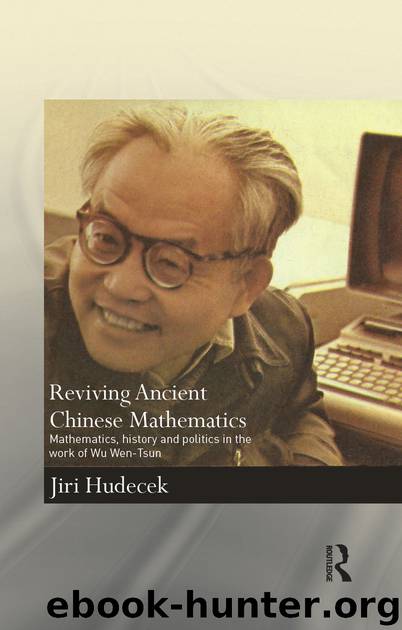Reviving Ancient Chinese Mathematics by Hudecek Jiri

Author:Hudecek, Jiri.
Language: eng
Format: epub
ISBN: 978-1-134-46832-4
Publisher: Taylor & Francis (CAM)
Notes
1 The article was, however, deemed unfit for publication in his selected writings (Wu Wen-Tsun 1986c, 1996).
2 See Dittmer (1991) for a survey of CPC’s distancing itself from the CR.
3 For science in general, the event that marked the end of the Cultural Revolution period was the National Conference on Science and Technology in Beijing in March 1978; see, e.g., Yao (1989: 470) or Yuan Zhendong (2008). This broader meaning of the CR period has therefore been adopted in some other recent studies on the history of science in this period, e.g. Schmalzer (2006).
4 A useful survey is in Esherick, et al. (2006: 6–16).
5 The story of Chen Jingrun and his sudden rise to national fame will be summarized later in this chapter. See especially Wang Lili and Li Xiaoning (1998); cf. Shen Shihao (1997) and Gu Mainan (2002).
6 ‘In some ways it will appear as if there were different Cultural Revolutions in different parts of the country’ (Esherick, et al. 2006: 17).
7 The IMCAS archives hold only payrolls and simple budgets for the years 1967–9.
8 During the Cultural Revolution, someone spiteful changed the original praise of Zheng Zhifu’s ‘clear class outlook’ to ‘bourgeois outlook’ using a red pencil.
9 There is much debate about the real source of factionalism in this early period. The older, class-based interpretation, elaborated, e.g., in Rosen (1982), seems invalid on many occasions when factional alignment stemmed more directly from responses to current events, such as to the dispatch of work teams to control and suppress the movement (Walder 2002).
10 Only the latter power-seizure is mentioned in the official CAS history (Fan Hongye 2000: 185).
11 Wu Wen-Tsun also took part in a group of younger researchers studying bionics (a discipline that attempts to replicate design from nature in technology) in 1968. Nothing is known about this episode apart from a brief mention in IMCAS (1975).
12 Du Junfu (2009b) claims that this latter phase of the campaign was harsher, and led to suicides in IPCAS too.
13 This happened to Xu Haijin , a specialist on computational mathematics who had returned from the USA in the late 1950s and had always been in trouble for spending a lot of time abroad (Lu Qikeng 2010; IMCAS 1972b).
14 For more about this movement, see Hu (2005); Qu Jingcheng and Xu Liangying (1984); and Hu Huakai (2006).
15 Compare the insider description of a May 7 Cadre School in Li Yaming (2005: 238–240) with the impressions of an American delegation from a carefully selected May 7 Cadre School in Fitzgerald and MacLane (1977: 90–1).
16 The treatises On Practice and Where does correct human knowledge come from? were studied collectively at IMCAS in 1971 (IMCAS 1972a). Wu Wen-Tsun was later praised for his thorough knowledge of On Practice (IMCAS 1975).
17 The consensus today is that there was never any ‘May 16 Conspiracy’ in the first place (MacFarquhar and Schoenhals 2006: 221–84). See Du Junfu (2009b) for what it was like to be a suspected conspirator.
18 Zou’s suicide was questioned by his widow after the Cultural Revolution (Jing Zhujun 1981).
Download
This site does not store any files on its server. We only index and link to content provided by other sites. Please contact the content providers to delete copyright contents if any and email us, we'll remove relevant links or contents immediately.
Waking Up in Heaven: A True Story of Brokenness, Heaven, and Life Again by McVea Crystal & Tresniowski Alex(37639)
Still Foolin’ ’Em by Billy Crystal(36256)
Cecilia; Or, Memoirs of an Heiress — Volume 1 by Fanny Burney(32408)
Cecilia; Or, Memoirs of an Heiress — Volume 3 by Fanny Burney(31812)
Cecilia; Or, Memoirs of an Heiress — Volume 2 by Fanny Burney(31785)
Fanny Burney by Claire Harman(26506)
Empire of the Sikhs by Patwant Singh(22956)
We're Going to Need More Wine by Gabrielle Union(18946)
Hans Sturm: A Soldier's Odyssey on the Eastern Front by Gordon Williamson(18453)
Plagued by Fire by Paul Hendrickson(17313)
Out of India by Michael Foss(16776)
All the Missing Girls by Megan Miranda(15478)
Cat's cradle by Kurt Vonnegut(15145)
Pimp by Iceberg Slim(14305)
Molly's Game by Molly Bloom(14045)
Bombshells: Glamour Girls of a Lifetime by Sullivan Steve(13949)
Leonardo da Vinci by Walter Isaacson(13139)
For the Love of Europe by Rick Steves(12569)
4 3 2 1: A Novel by Paul Auster(12260)
